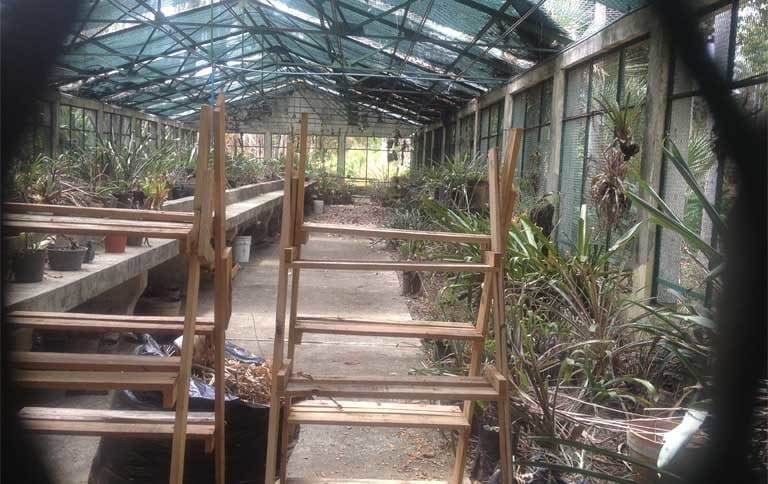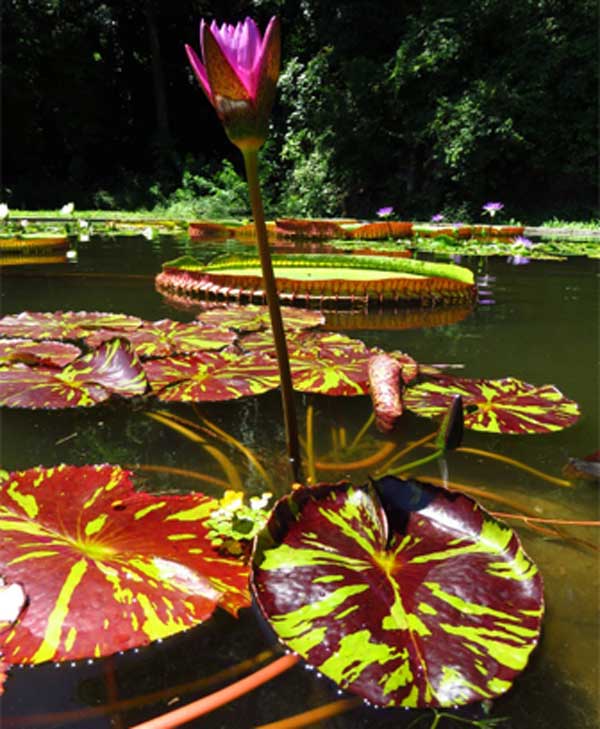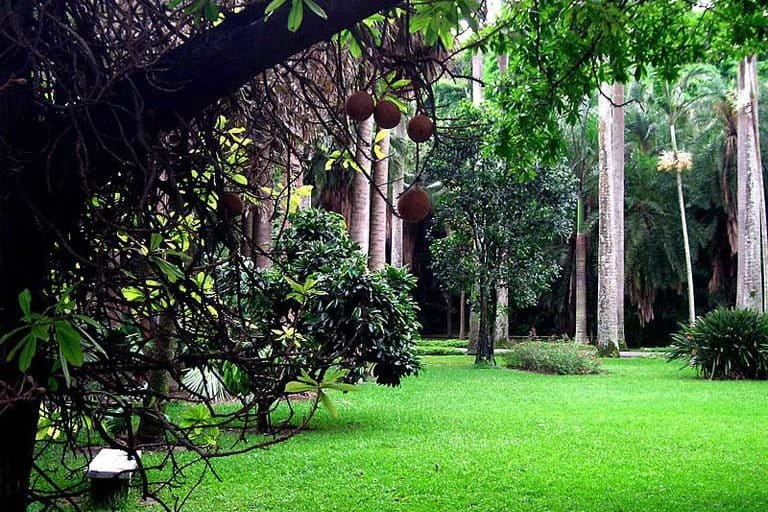- Venezuela’s Botanical Garden of Caracas was declared a UNESCO World Heritage Site in 2000. Its 70-hectare (173-acre) garden, National Herbarium and Henri Pittier Library are considered a national, and international treasure, and a vital repository of Latin American and global natural history utilized frequently by researchers.
- But a devastating drought that started two years ago, plus massive thefts of equipment (ranging from air conditioners to computers, plumbing and even electrical wiring), plus a failed electrical and public water supply, have all combined to threaten the Garden’s priceless collections.
- The annual botanical garden budget has been slashed to a mere $500 per year, which has forced staff to rely on innovative conservation solutions which include crowd funding to pay for rainwater cisterns, as well as volunteer programs in which participants contribute not only labor, but irrigation water they bring from home.
- As Venezuela’s government grows increasingly corrupt and incompetent, and as the national economy spirals out of control with hyperinflation topping 1.7 million percent in 2018, the botanical garden’s curators have no ready answers as to how to go about preserving the rare plants they tend on into the future.

Without water, life itself is impossible: the staff of the Botanical Garden of Caracas has labored against this natural edict for more than two years, as the UNESCO World Heritage Site struggles to keep its precious international plant collection alive against severe drought, a failed city electrical and water supply, and amidst one of the worst humanitarian emergencies ever endured by a Latin American nation.
The Garden, in Spanish known as the Jardín Botánico de Caracas, is part of the Universidad Central de Venezuela, Central University of Venezuela, campus, and was declared a World Heritage Site in 2000. At its height, the Garden conserved more than 2,500 species corresponding to roughly 200 botanical families, of which 50 percent were endemic to Venezuela, with the rest coming from Central America, Africa, India and other parts of Asia and South America. Its Palmetum was renowned for having one of the finest collections of palms in Latin America, housing some 4,000 specimens of about 250 species.
But year-by-year, day-by-day, this natural treasure house has become increasingly impoverished, with many exotic plants, dozens of native and endemic species such as orchids and palms dead or dying due to a lack of irrigation, or overrun by grasses.
The gardens’ largest lake, constructed in the shape of Venezuela and covered in immense flowering water lilies, was half emptied by July of 2018, according to Reuters. Dead is one of the lake’s most prized and celebrated species, the giant 2.4-meter (8 feet) wide, Santa Cruz water lily (Victoria amazonica), so big and buoyant it can support a child’s weight.


A long, grinding crisis
The garden’s decline began well before the current Venezuelan economic crisis. The El Niño drought of 2010 and the invasion of the giant African snail seriously impacted this urban oasis, located near the center of the city of Caracas beside the Francisco Fajardo Highway. But those crises were a mere prequel to the current dysfunctionality now suffered by the facility according to its director, Jan Tillett, a Venezuelan agronomist who has worked at the Garden for 16 years.
Founded in 1945 and opened to the public in 1958, the Botanical Garden of Caracas occupies 70 hectares (173 acres), with its value greatly enhanced by the Henri Pittier Library with its 6,000 volumes, and by the National Herbarium — all of these holdings are administered by the National Botanical Institute of Venezuela Foundation.
These day, the staff of all three entities are crammed into common spaces because their office complexes lack basic services. As the Venezuelan economic crisis deepened in 2017, a wave of robberies deprived the Garden’s facilities of their air conditioners, water pumps, refrigerators, computers and other important tools, leaving the institution’s infrastructure in a precarious condition. That year the Venezuelan National Guard was ordered to withdraw its protection from the Garden and many surrounding Caracas neighborhoods in order to face the massive citizen protests against the controversial and notoriously corrupt government of Nicolás Maduro who was elected president in 2013.
At the time, Garden officials made 21 formal complaints to authorities and pleaded for help, to no avail. “Everything was stolen,” Tillett laments. “Bilge pumps, clippers, hoses, a power plant, and even the ceilings, but the police did nothing.” Petty thefts have continued to occur daily.
There is virtually no money available with which to replace the losses. The Garden received an operating budget for 2019 totaling 3 million bolivars, the equivalent of 500 dollars. Meanwhile, bureaucratic breakdowns have become so severe that the elapsed time between the approval of building permits and the execution of maintenance can be so long that Venezuela’s hyperinflation (1.7 million percent during 2018), can consume all the money before a hand is raised to accomplish a task.
Then there are the issues surrounding water. “The last time water entered the [facilities’] pipelines was between January 14 and 16 this year,” laments Tillett.
That drastic lack spawned a social media campaign to raise funds to pay for 200 water cisterns to supply vital water to aquatic plant lagoons and to perform manual irrigation. A volunteer program was also created and is coordinated by the garden’s chief researcher, Yaroslavi Espinoza. Volunteers not only do maintenance, they bring water from home in bottles to irrigate plants.


Lack of water takes its toll
Despite these heroic efforts, a visit to the once magnificent Garden is cause for gloom. Near its entrance a large lagoon now sits dry and empty. Nearby, numerous stumps are a reminder of tropical tees felled at death. Other water-stressed trees stand with bare branches, or festooned with dying leaves, surrounded by yellowing grass.
The ethnobotanical garden area, which should exhibit plants with medicinal and gastronomic uses, looks like an abandoned farm with dead fruit trees, a common sight these days in the Venezuelan countryside. One small lagoon has been filled up from cisterns and boasts a few aquatic species, but several others stand empty, damaged by recent earth tremors in Caracas. “The scientist in charge of these species has reproduced some of them and taken them to other places so that they do not get lost,” explains the Gardens’ director.
But such efforts continue to be undermined. “We lost all the seedlings that were in the main nursery outside the exhibition area, where [thieves] stole the roof, so having their [water] tank full was worthless,” says Tillett. The plants died under a baking tropical sun. The staff tried to reactivate a fifty-year-old deep well, but could raise no water, probably due to the long drought and the theft of electrical wiring that operated water pumps. Since the wave of countrywide blackouts in March of this year, many city pumping stations have stopped working, making water supply problems even more intractable.
Still, all is not lost. Tillett’s team has been able to conserve several species of palms of the genus Cicadas, and pines in the so-called Paleozoic Garden and the Arboretum, where trees tens of meters tall have stayed green thanks to the moist microclimate they themselves generate. Despite everything, the Garden still attracts visitors and lots of birds. “There are parrots, macaws, guacharacas (Ortallis genus) and white herons,” the director says.


Plagued herbarium
The National Herbarium has its own unique problems. Its immense botanical collection is being devoured by ladybugs. The lack of a cooling system has imperiled the samples of 450,000 plant species once well protected within the herbarium. As a result, a pest, the cigarette beetle (Lasioderma serricona) now infests almost all the samples of Venezuela’s lichens, fungi, algae and other vegetal biodiversity.
The theft of nine air conditioners, dehumidifiers, furniture, shelves and computers forced Dr. Neida Avendaño, Herbarium director since 2017, to get creative. In order to protect samples from infestation, he ordered the storage of each in a plastic bag. At first, paradichlorobenzene mothballs were added to each container, but cheaper naphthalene was later substituted. Unfortunately for the plants, tropical heat and drought evaporate the mothballs quickly, forcing Avendaño and researcher Dr. Omaira Hokche to check and replenish the bags often, in a tedious and frustrating daily routine.
Avendaño underscores the critical importance of protecting the museum research collection’s 750 typus and paratypus (a specimen of an organism that helps define the scientific name of a species and other taxon characteristics), along with 520 historical samples, some from the 17th century.
The collection “has historical, genetic and scientific importance,” says Avendaño. “I worked here twenty years ago in research. Botanists, doctors and chefs come [to the herbarium] to request samples to investigate.” But even with the help of a private donation from a German researcher, there are still 20 years-worth of stacked samples awaiting protection.
In the failed state of Venezuela, getting outside help for one of the world’s great botanical collections has been complicated and slowed by the nation’s cumbersome bureaucratic processes. Avendaño waits patiently in hope of assistance from the international scientific community, but she worries that help will not come. “I think they really do not believe that we work without water, without electricity, without toilets, building a database [working from home] with our [own personal] computers,” she concludes.
FEEDBACK: Use this form to send a message to the author of this post. If you want to post a public comment, you can do that at the bottom of the page.

